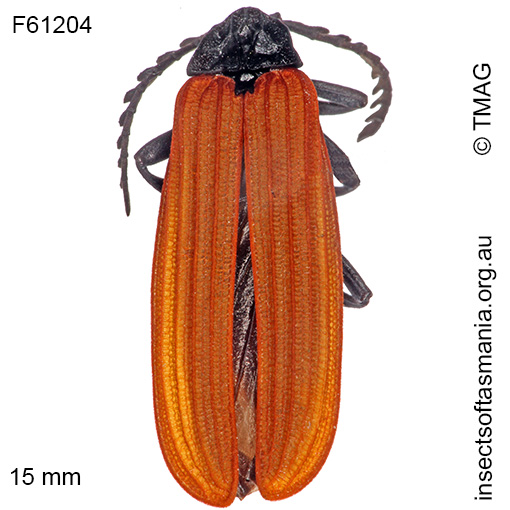
Porrostoma rhipidium (W.S. Macleay, 1826) (a species of net-winged beetle)
Basis for Tasmanian occurrence
Semmens, T.D., McQuillan, P.B. & Hayhurst, G. (1992). Catalogue of the Insects of Tasmania. Government of Tasmania: Department of Primary Industry, 104 pp. (as Metriorrhynchus rhipidium)
TMAG collections
Classification
Order: Coleoptera
Suborder: Polyphaga
Superfamily: Elateroidea
Family: Lycidae
Subfamily: Metriorrhynchinae
Tribe: Metriorrhynchini
Morphology
Typical length (mm): 14
Flightedness: winged and assumed capable of flight
Morphology (characterised by L. Forster): — Elytra completely orange with double rows of punctures — Head with long rostrum — Pronotum black, divided into seven distinct areolets — Wings present.
Source literature on morphology and taxonomy (*primary taxonomic source, where identified):
*Lea, A.M. (1909b). Revision of the Australian and Tasmanian Malacodermidae. Trans. Roy. Entom. Soc. Lond. 1909: 45-251. [Pages 52, 79-80]
Ecology
Assumed larval feeding: predator
Association with dead wood or old trees: at least facultatively saproxylic
Ecological attributes: — May occupy logs or trunks of Eucalyptus obliqua, at least temporarily, since found having emerged within six years of felling (Grove et al., 2009).
Collection method(s) for TFIC material: — Emergence trapping from cut billets of Eucalyptus obliqua (Harrison, 2007) — Emergence trapping from log of Eucalyptus obliqua — Flight intercept trapping (trough below Malaise trap) — Hand collection (substrate not specified) — Hand collection from flowers of Eucryphia lucida (Ettershanks & Ettershanks, 1993) — Hand collection from flowers of Eucryphia milliganii (Ettershanks & Ettershanks, 1993) — Malaise trapping — Pitfall trapping — Sticky trapping on Eucalyptus globulus — Sticky trapping on Eucalyptus obliqua.
Source ecological literature:
Grove, S.J. (2009b). Beetles and fuelwood harvesting: a retrospective study from Tasmania’s southern forests. Tasforests 18: 77-99.
Daley, E. (2007). Wings: an introduction to Tasmania’s winged insects. Hobart: 40 Degrees South Pty. Ltd., 236 pages.
Grove, S. et al. (2009). A long-term experimental study of saproxylic beetle … succession in Tasmanian Eucalyptus … logs… In: Fattorini, S. (Ed.), Insect Ecology and Conservation. Research Signpost, pp. 71-114.
Harrison, K.S. (2007). Saproxylic beetles associated with habitat features in Eucalyptus obliqua trees in the southern forests of Tasmania. PhD thesis, Dept. of Zoology, Univ. of Tasmania, Hobart.
Moore, B.P. & Brown, W.V. (1981). Identification of warning odour components, bitter principles and antifeedants in an aposematic beetle: Metriorhynchus rhipidius (Coleoptera: Lycidae). Insect Biochem. 11: 493-499.
Yee, M. (2005). The ecology and habitat requirements of saproxylic beetles native to Tasmanian wet eucalypt forests: potential impacts of commercial forestry practices. PhD thesis, Univ. of Tasmania, Hobart.

